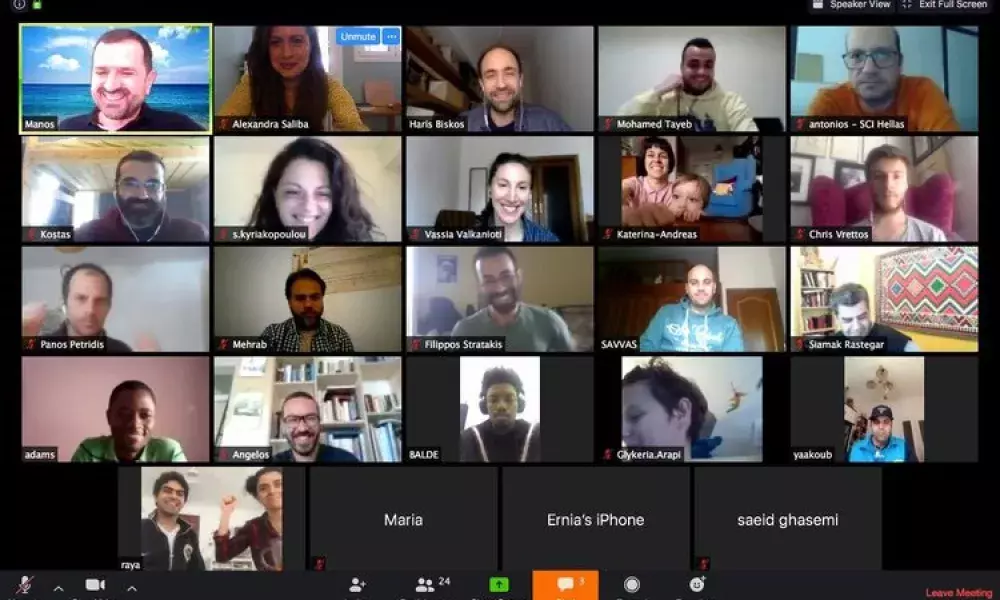
1 Executive Summary
These challenges affected all participants of the programme. Despite the rapidity of the pandemic’s escalation, the project’s transition to an online operation was fast and firm. Staying connected with all refugees, however, proved to be a difficult task: the most vulnerable beneficiaries often have precarious internet access and insufficient data plans to follow regular online activities. These difficulties were reflected in a noticeable decline in the participation and engagement in classrooms and in the rise of dropout numbers.
In the meanwhile, the digitalisation of the programme increased the programme’s outreach by opening the activities to those refugees who could previously not travel to the Serafio regularly to attend classes and trainings. Other activities, like Curing the Limbo’s housing programme were successful to move all activities into the digital space, including virtual visits to apartments and online meetings to match owners with prospective tenants. To safeguard this extended outreach and bring back some of the beneficiaries lost during the lockdowns, classes reopened in the autumn of 2020 with a mixed model of offline and online learning. While creating new barriers of access, this hybrid system provided a safer and more engaging way of learning, with the opportunity of including more refugees in the programme on the long run.
This Journal accompanies Curing the Limbo in its last year of progress. By examining the impact of the Covid-19 pandemic and the subsequent lockdowns and exploring the responses given by the partners of the project, this fifth issue of the UIA Journal looks at the resilience and adaptiveness of the consortium when facing unexpected challenges. This chronicle of the project was created during a long period of 2021, following a series of online events, calls and interviews with the project partners.
2 Progress
“The feedback I got from many people was that we were remarkably able to adapt.” Antigone Kotanidi, Curing the Limbo project manager
2.1 Organisation and partnerships
The year 2020, for the Curing the Limbo project, as for many processes around the world, was to a great extent thematised by the Covid-19 pandemic and the several consecutive lockdowns. It tested individuals, partnerships and, more broadly, the project itself; and reshaped some of the collaborations and means of organisation with regards to the various pillars of Curing the Limbo project.
The accelerated digital transition brought about by the Covid-19 lockdowns has put many organisations in difficulties. As not all partners involved in the partnership and its activities had been fully prepared technologically, the digitalisation of the project’s activities was seen as an important challenge. However, feedback from both internal and external partners affirmed that the project’s transition to an online day-to-day operation was swift and surprisingly seamless, as a necessary reaction to the first Covid lockdown introduced in Athens back in March 2020. This allowed the consortium to continue providing services to beneficiaries at a time when support was needed more than ever. Additionally, this new form of (primarily) online presence in the first few months of the pandemic allowed the project to reach out to even more people than before, being able to transcend geographical and commuting restrictions. In terms of the quality of services provided by the project, the partners agreed that they managed to sustain the same degree of quality as before – even with some newly emerging challenges.
“People who were not able to come to Serafio before, now had the tools to connect to people and activities online. And this was great for the programme.” Antigone Kotanidi
At the start of the pandemic there was a lot of uncertainty around the effectiveness of staying connected with project partners. Nevertheless, the efforts of the Curing the Limbo consortium to move their activities online were successful. As a surprising result, the situation brought the consortium members closer: they had additional time to discuss gaps in the programme, and additional online meetings gave them more space to discuss what they did not always have time for in person. Nevertheless, it was often a challenge to stay connected to participants and keep the services up and relevant. As it is often the case with vulnerable groups, many beneficiaries of Curing the Limbo did not have sufficient Internet connection to participate in activities or were concerned with other problems in their life.
Overall, teachers experienced a certain level of disengagement in some of the educational activities and a number of participants were lost throughout the Spring and Summer as a consequence of the lockdowns. This was particularly true in the case of activities that originally took place in the Serafio complex. Even though the overall number of refugees that remained enrolled in the programme did not change drastically and stakeholders remained active in the different activities, the decline in both participation and engagement in classrooms was noticeable and was even bigger during the second lockdown.
The challenges were different for every pillar of the project, from Co-Athens, that had to be launched under the shadow cast by the pandemic, to the classes that had to be taken online, sometimes forcing students to participate with their phones. To resolve this issue and to foster more involvement and participation of refugees, parts of the programme were reopened in the autumn, and teaching continued in a mixed model of online and offline learning. The numbers showed that, even in the face of dropouts, the project managed to keep in touch with a large percentage of participating refugees.
“For a population already in “limbo”, it was important to be able to stand next to them when they re-entered an even more uncertain Limbo.” Antigone Kotanidi
The return to Serafio in the Autumn was also challenging, both from an organising point of view but also from the viewpoint of participants, who were often anxious to take the bus or the metro to come to the site in person. Thus, this also meant that additional refugees were lost from the programme even after introducing the mixed model of learning. In this new kind of hybrid system some meetings were online, others were in person, with in-person classes held in Serafio. Overall, the hybrid system has its drawbacks and benefits: while it creates new barriers to access, it also combines safer and more engaging elements of learning and provides the opportunity on the long run to give access to more refugees to be included in the programme.
Dealing with the new, emerging challenges related to Covid-19, however, had a number of positive outcomes as well. For one, partnerships within the consortium became stronger and more resilient due to the joint efforts needed to address many of the arising issues. Both consortium partners and beneficiaries proved to themselves and to each other their unequivocal commitment to the values and goals of the project through their concerted efforts to maintain the cooperation, services and participation. This was not that significant a challenge because project staff, from the very start of the project, were used to having to flexibly adapt to newly occurring circumstances. The ability of partners to quickly adopt new methodologies, learned through the action-research methodology and the agile operation of pilot programmes of the project, came handy when having to reorganise the logistics, outreach and platforms of Curing the Limbo.
At the end of a long year and building on the conclusions of tackling some of its challenges, project partners participated in a capacity building workshop organised by the Education component of the project in November 2020. Here, they focused on the successes, difficulties and crisis points of the year; and how they were able to overcome them, what they learned from them and how they could capitalise on them moving forward.
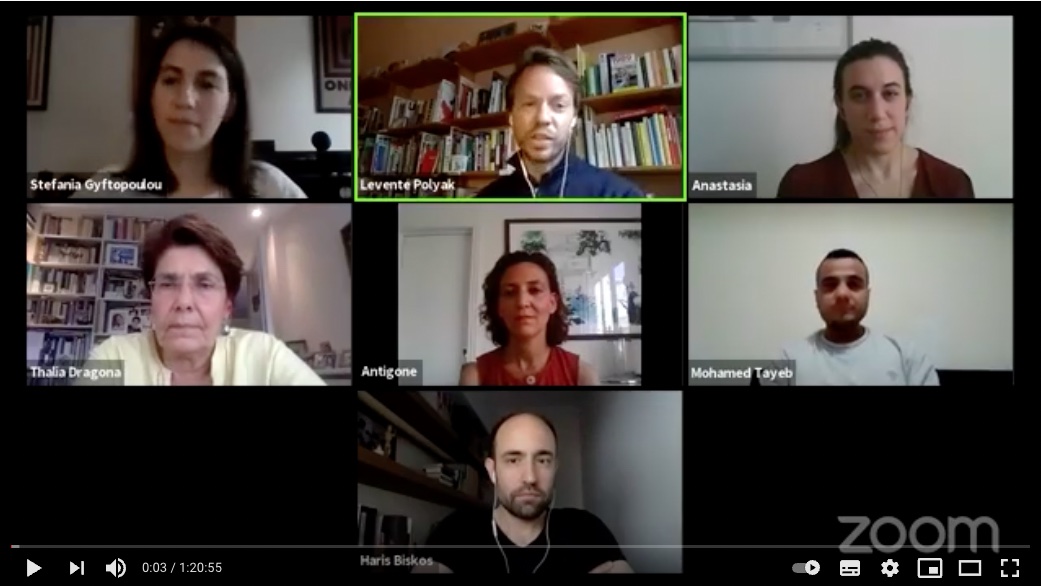
2.2 Trajectories
Beneficiaries in Curing the Limbo have, in many ways, undergone similar experiences during the Covid-19 pandemic and the lockdowns as everyone else. Job insecurity, social isolation, general uncertainty and anxiety were some of the feelings many Athenians (and the majority of people across the globe) had to deal with. That said, refugees often lack support from family, friends and neighbours or at least they benefit less from such supportive connections than people who are more embedded in local society. For this reason, the support system provided by the programme became ever more crucial; both with regards to financial uncertainty and job insecurity, as well as psychological support.
“Before COVID-19 there were lots of discussions about the refugees due to some issues at the border, generating stigmatisation and prejudice. The lockdown shifted the attention away and the animosity against refugees dropped. It stopped an escalating trend of xenophobia. But most likely it will come rise again at some later date.” Thalia Dragona
Refugees in Athens, if they had employment prior to Covid, were often working in precarious jobs. The instantaneous halt of tourism, and many businesses in the service sector meant that many of them lost their jobs and the prospects of those who were seeking a job pre-Covid also became more bleak. This meant that there was increased pressure on education and employment programmes to try to help these individuals with varying success. Only a marginal number of beneficiaries managed to find new employment during the pandemic.
In terms of the engagement of beneficiaries and their participation in courses, the programme witnessed various tendencies. During the first wave of the pandemic, engagement was high and refugees were eager to find ways to stay connected with instructors and coordinators of the programme, both inside and outside online classroom activities. This, according to educators and trainers, gave everyone a sense of stability and comfort when everything seemed uncertain during the first few months of Covid. Course engagement and participation during the Summer, however, declined. This phenomenon was not surprising, as dropout rates during Summer months have been higher in previous years, as well. One difference in 2020, compared to earlier years, was that most of those who dropped out this summer, did not re-enter upon the arrival of Autumn; therefore the overall dropout rate of 2020 was slightly higher than before.
2020 and the Covid-19 pandemic brought significant challenges even in the lives of refugees who established a certain degree of stability in their new lives. Mohamed Tayeb exemplifies this experience: after joining the programme, learning Greek and taking audio-visual classes, Mohamed gained access to Curing the Limbo’s housing programme and got a job in a theatre. He was working on the production of Phantom of the Opera when the coronavirus emerged.
“When we were forced to stay home and close ourselves during the lockdown, I was really sad. At the moment all theatres are closed and there is no news of plans to reopen. Last week, however, I got a job offer from a call centre. Although I would like to continue working in the theatre sector, one has to adopt to circumstances.” Mohamed Tayeb
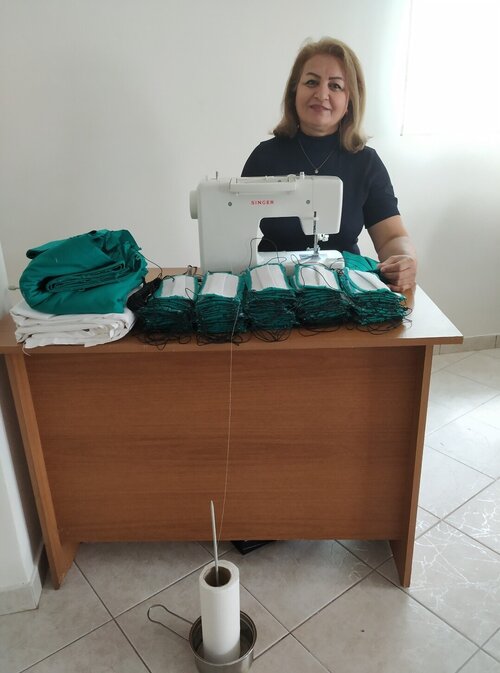
2.3 Education
During the first wave of the Covid-19 pandemic, when lockdowns were introduced for the first time, the education pillar of Curing the Limbo had to make a swift transition from in-person to online methods of learning, or with Thalia Dragona’s words, “emergency remote learning.”
The transition to online activities brought about inequalities from the start, which fundamentally affected the everyday operation of the education programme. The bulk of the challenge was to be able to respond to individual needs of students, since individual restrictions and limitations regarding access were far from uniform. Many students did not have a computer, while others had access to one, but had no, or limited access to the Internet. Because the transition to online means of communication had to be carried out from one day to the other, even simply getting hold of students often proved to be a challenge; the right informational infrastructure simply was not always available. This meant that teaching, as was carried out before, grounded to a halt at the beginning of the pandemic; both ways and means of teaching needed to be rebuilt, often from the ground up.
In order to tackle these challenges, the National and Kapodistrian University of Athens launched a pilot project where educators tried different means to get in touch with students and were consequently driven to develop a methodology called mobile assisted language learning. This led to the introduction of courses taught via phones through WhatsApp and Viber, as well as using social media platforms. New types of courses were introduced, better suited for online learning, while others (e.g., housing workshops, pre-tenancy training and language courses) were being tailored to be carried out in the online domain. Educators also had to introduce types of training that would build the resilience of students under these changing circumstances and difficult times, but at the same time, could be carried out remotely. Both students and teachers contributed ideas leading to this digital transition: for instance, in a new photography course students could upload their photos on a website and would talk about their works of art in online group sessions. Most of the feedback received on such initiatives were very positive: students appreciated the fact that they were able to stay connected, retaining a sense of community amidst times of uncertainty.
The courses carried out on new platforms, via the internet or via telephone, brought about novel administrative challenges. Initially, it was uncertain whether or not the project’s financial administration would agree to these necessary changes. One complication, for example, was that teachers are paid by the hour and it is difficult to prove that one has delivered a three-hour class via telephone. This tension between the project’s remodelled needs on the ground and its contractual obligations was resolved through direct communication between members of the Curing the Limbo partnership and UIA, and a solution was reached with the help of UIA’s flexibility to adjust spending to the actual necessities.
As the lockdowns dragged on, many of the pre-Covid classes were not taught in the classical sense; but even if some courses were involuntarily discontinued, teachers and students kept in touch. If we look at this from a different viewpoint, integration has a lot to do with how well one speaks the local language, but another very profound and efficient way of fostering the integration of refugees is to create and sustain a connection between the newcomers and the Greek population.
“If refugees feel that their instructors are there for them, if they feel someone truly cares for them, they get a sense of reassurance that host society is there to support them; that is psychologically very important. This gave a sense of security for them during the lockdowns.” Thalia Dragona
With the end of the first lockdown in Athens, the conditions did not significantly improve for Curing the Limbo’s education programme. Many students became less engaged, because they were no longer constantly at home and were no longer that eager to participate via online platforms, but many other factors also contributed to this notion of disengagement. Returning to the Serafio complex was not without any difficulties either. When some of courses were brought back to the classrooms, educators and students faced rather strict rules to be followed when facilitating in-person classes, following social distancing principles. A further complication that hindered everyday education activities and added to the already challenging circumstances were administrative difficulties: it became a major administrative challenge both for teachers and the project to report on various changes occurring in the classrooms. As a result, some instructors dropped out, others were asked to take on extra hours and some new ones entered, also adding to the administrative burden.
“When they came out of the lockdown it was like coming out of a cocoon. They were afraid, and they were ambivalent. People felt all their problems magnified. Their difficulties increased, while their job prospects and other opportunities shrank.” Thalia Dragona
However, despite all challenges, the education component of Curing the Limbo weathered relatively well the difficulties of 2020. Many students completed classes and received their certificated in some of the areas taught. The lockdowns forced educators to experiment with new educational methods, including hybrid teaching techniques, combining in-person and online classes as well as joint curricula in English and Greek. Classes were also better connected to the housing component of Curing the Limbo and beneficiaries participating at audio-visual workshops during the Covid lockdowns participated at an exhibition.
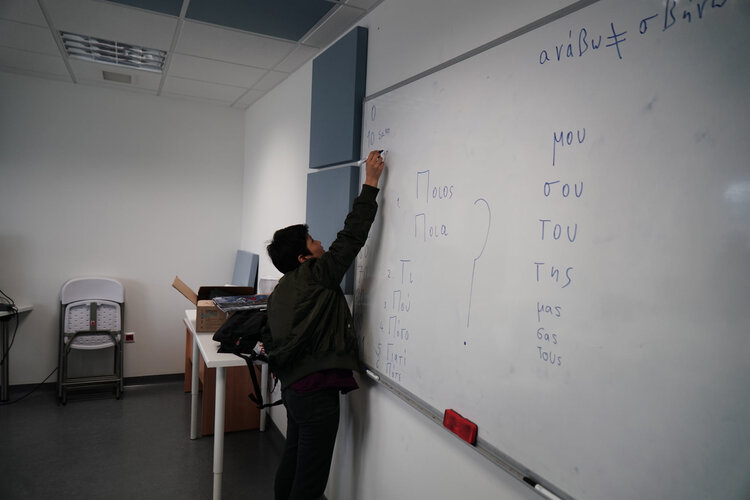
2.4 Employment
Similarly to other components of Curing the Limbo, employment trainings were also quick to make the transition to the online domain once the lockdowns during the first Covid-19 wave started. IRC’s focus on how to secure a job remained the same but the organisation also reached out to businesses in sectors that had a higher demand for employment under new circumstances, like supermarkets, logistics or delivery. While four refugees found employment during first pandemic lockdown period, a higher number of jobs were also lost by many those prior working in tourism or in restaurants.
Employability services were continued, with some necessary changes regarding the platforms on which trainings were carried out. Job readiness courses were moved to Zoom and mock interviews were carried out via phone calls. The transition from face-to-face to online activities was efficient and fast-paced. The new situation gave more focus to connectivity with beneficiaries. IRC created a tool to follow the progress of beneficiaries and see which services they were attending online each week.
“When you try to have an in-depth conversion about what they are interested in, while the connection keeps shutting down, or they are not able to join for a 45-minute phone call due to restricted access to the Internet, or they are on a busy bus or other distracting circumstances; all that hinders effective communication.” Anastasia Sikiaridi
The first lockdown in Athens coincided with personnel changes within IRC that introduced new challenges to the project with the necessity of training new staff and adapting to the new situation brought by Covid-19. In the meanwhile, new staff members also brought with themselves new energies, as well as fresh and creative ideas. Reaching out to beneficiaries also brought along its their own challenges, that were not clear at the beginning of the lockdown. The challenges brought by this transition to digital means had only surfaced gradually and culminated as the restrictions introduced to tackle the pandemic dragged on into the Autumn.
“When you deal with beneficiaries with whom you are in regular contact with, you form a relationship, you know the next steps, you do coaching. But all this is much more difficult when you meet someone first time through an online platform.” Anastasia Sikiaridi
IRC’s work is organised around employability: most of the activities organised in Curing the Limbo’s “employment pillar” focus on soft skills necessary to find employment, including trainings, information sessions, coaching, counselling and language courses. Although a number of these services needed to be discontinued as a result of the pandemic, IRC staff used the opportunity offered by the pandemic to plan additional services they could offer to beneficiaries once restrictions are lifted: visits to companies, company outreach, and a new edition of the job fair successfully organised before the pandemic. Another new service introduced during the lockdown was a job search-focused training where IRC staff supported beneficiaries with job applications.
Besides creating difficulties in providing in-person trainings, the pandemic has also radically altered the job market. Job opportunities in tourism, previously offered during summer months, were difficult to find this year and therefore the sector could provide much less refugees with temporary (and potentially permanent) employment than before, partly due to the scarcity of work but also to the lack of preparedness among beneficiaries. Language remains a crucial factor of employability: without Greek, it is difficult to access employment, but English is another requirement for many jobs. However, learning two languages at the same time can be overwhelming for refugees, therefore learning priorities can be confusing for many job seekers.
The rate of job placement among refugees was 18% in October 2020, a proportion comparable with the success rate of other employability companies. However, many refugees that had already had jobs before the pandemic, saw their working hours reduced and their revenues decreasing. During the first lockdown of the pandemic, only 1% of the beneficiaries managed to find a new job, mainly in logistics. To address this issue, IRC organised a series of open webinars in October where representatives of various sectors talked directly to the refugees about how they need to apply to jobs in their sector, what skills are companies looking for, and what to emphasise during a potential interview.
Overall, one of the gravest result of pandemic was its impact on the labour market and on the prospect of getting employed in the near future. Many jobs in the service sector (tourism, restaurants etc.) previously accessible to refugees have disappeared, some partially, others completely. This void potentially could be filled with agricultural vacancies, but whether or not they can provide an alternative avenue of employment depends on whether refugees are willing to leave Athens and relocate to the countryside.
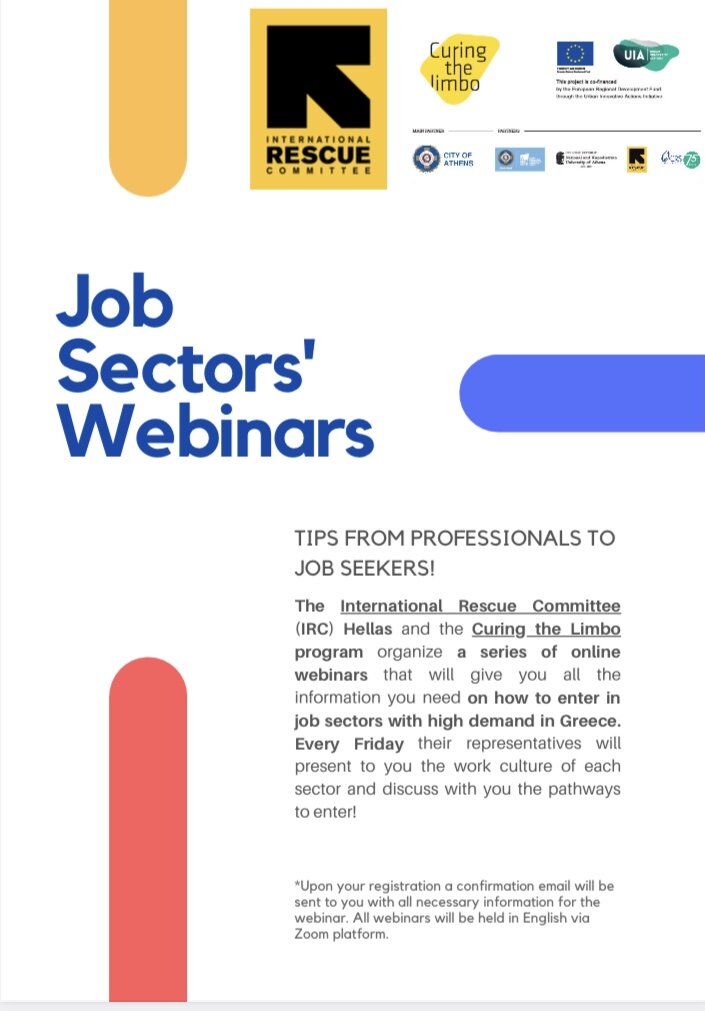
2.5 Housing
In parallel with other aspects of Curing the Limbo, housing provision has also been affected by the Covid-19 pandemic. Curing the Limbo’s housing programme acts as an intermediary between home owners and beneficiaries offering them a range of support services and financial assurances. With the emergence of COVID-19, the CRS team was forced to reduce physical meetings and move many activities online, introducing digital tools to assure the continuity of various services, including virtual visits to apartments. The team was quick in establishing new communication channels and switch to online services. In order to increase the programme’s outreach and connectivity with beneficiaries, several refugees who otherwise had limited access to the Internet, were offered a top up or an upgrade of their data plans. This digital transition also allowed beneficiaries to acquire new skills: learning how to pay charges and services online, using a variety of apps, made them more autonomous in managing their daily lives.
The new situation brought about by the pandemic also helped CRS members in restructuring their relationship with beneficiaries as well as with each other. The housing team organised a series of reflection meetings, focusing on various challenges brought by the pandemic as well as the evolution of Curing the Limbo’s housing programme. These reflections also gave an opportunity for the CRS staff to begin planning their exit strategy from their roles as intermediaries between home owners and beneficiaries, allowing these relationships to continue on their own.
With tourism put on hold across Greece, an increased supply of long term rentals, especially smaller apartments, began to appear on the market, which has led to a small drop in rental prices. This window of opportunity led CRS to negotiate a number of new leases during the first wave of the pandemic, reaching a total of 92 rental contracts for refugees. However, the success of bringing more apartments into the programme was counterbalanced by the negative impact of the pandemic: many refugees lost their jobs as a direct consequence of the successive lockdowns, or found themselves in precarious positions due to the reduction of working hours. In the meanwhile, the shrinking labour market of Athens reduced the possibilities of finding new jobs. As a result, a number of beneficiaries who had reached the end of their subsidised rental period and were suddenly deprived of a regular revenue stream, were not able to afford to maintain their contracts of find new housing on their own.
Curing the Limbo stopped recruiting new apartments for its housing programme by Autumn 2020, after reaching its target and the limits of its capacity, and from then on the CRS team began to focus on strengthening existing households, instead of expanding its outreach. This focus also included work towards a better understanding of refugees’ modes of living and support to better use their apartments. As part of the “How to” guide, a lexicon of housing was created to help beneficiaries navigate among the notions and keywords related to housing. In another initiative, CRS team members worked closely with participants of Curing the Limbo’s audio-visual trainings to explore their notions of home and the ways in which they experienced the lockdown in an exhibition.
Besides its attention on beneficiaries and their households, the CRS also began to focus on the legacy of Curing the Limbo within Athens’ housing sector, working towards developing one of the key outcomes of the housing programme, a model for a social rental agency for Athens. Building on the learnings of Curing the Limbo’s housing subsidy scheme, the social rental agency to be conceived by the CRS team with the help of external consultants, will be designed to be a sustainable, long-term scheme to provide affordable housing for vulnerable social groups. A housing symposium, aiming at bringing together a variety of models, insights and experiences to support this process, was postponed from Autumn 2020 to Spring 2021.
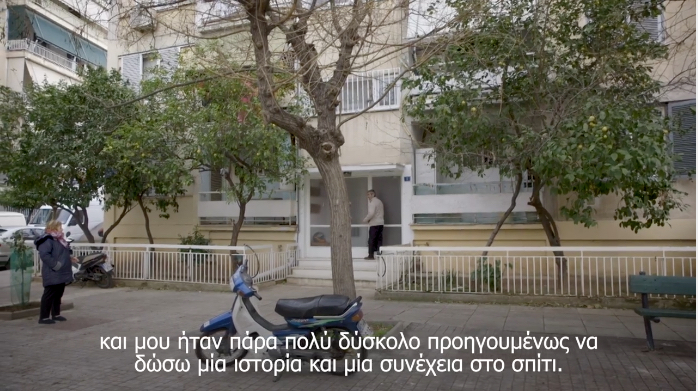
2.6 Community and active citizenship
As a consequence of the consecutive lockdowns, community gatherings and events have been significantly reduced across Athens. Active citizenship activities, probably more than any other elements of Curing the Limbo, could have been severely disrupted by the pandemic. After the first phase of the Co-Athens process, 20 proposals were selected to create groups composed by refugees and active local citizens. The second phase of Co-Athens was launched in February 2020 just before the first lockdown in March. Despite the difficulties posed by the pandemic, Co-Athens managed to sustain collaboration involving all parties, and the process remained active in communicating with various citizen groups through online means, organising seminars and coaching sessions alike. Throughout the first wave of the pandemic, Co-Athens had successfully retained the approximately 150 participants involved in their initiatives.
In their efforts to keep people together through digital channels and online meetings, the synAthina team and Co-Athens projects shared the challenges of most community groups and social initiatives in Athens. The series of empowerment events and seminars, organised before the pandemic to create connections between refugees and locals, prepared and helped the teams to get through this period together. As a response to Covid-19 and the lockdowns, a variety of new initiatives were launched in Athens that the Curing the Limbo teams could support with capacity building and training courses.
“Communities in Athens responded to the crisis with many activities: food distribution, face masks, blood donation. Many existing solidarity initiatives were scaled up by the pandemic that prompted citizen groups to find solutions that the state or city governments could not. I think new ways of innovation will emerge from this new kind of solidarity.” Harris Biskos
Similarly to other community initiatives across Athens, the pandemic brought a specific momentum and challenges for Co-Athens projects. As they were all conceived and planned in pre-Covid times, some of them needed to be adapted to changing circumstances and a reshaped environment. The projects could only formally start later in the year, after initiative proposals were submitted to and accepted by the municipality (altogether 14 proposals were submitted); but many started out earlier in practice due to the increased eagerness and anticipation of participants formed around them.
For example, both refugees and local communities were interested in sports. Several local neighbourhood initiatives invested in sports to revitalise public space. One project started nurturing a football academy which aims to revive an abandoned basketball court owned by the municipality. It is a common space regeneration project but also has a direct links to the community through involving people in the sports academy. The academy was conceived to be run by the refugees collaborating in the programme who have been taking a leading role in the project from the very start.
Other Co-Athens initiatives include: a pop-up food lab and an inter-cultural music community which is piloting the creation of shows and musical instruments in Kolonos. There is a project focusing on urban games, bringing traditional Greek-Athenian urban games into the Kerameikos area. There is also an initiative to create an energy community, bringing together local residents and experts to experiment together with the generation of alternative forms of energy, later culminating in a shared economy project. Finally, another project centres around Greek language courses, matching volunteer university students with beneficiaries to practice Greek with them and prepare them for the oral part of their language exam. These new collaborative projects were been the pitched to the local leaders of municipality and representatives of the Development and Tourism Promotion Company (EATA) who were very impressed and supportive of these ideas and action plans.
Even with the success of several cooperation initiatives between local communities and refugees, the modalities of cooperation also highlighted the limits of volunteering. Local communities and active citizens, despite their dynamisms, dispose of very limited capacities. Although they are considered as beneficiaries of Curing the Limbo, but participation in the programme also consumes their sparse resources. The modalities of involving local communities, therefore, had the rethought and adapted to their needs and possibilities.
The second wave of the pandemic and the second lockdown halted the enthusiastic development of the new Co-Athens initiatives. Due to the re-introduction of emergency measures, personal meetings and gatherings as well as in-person collaboration were suspended. Restrictions made it impossible to have group gatherings even in open spaces. Most of the projects came to a standstill, ready to restart once circumstances would allow for communities to interact in person again.
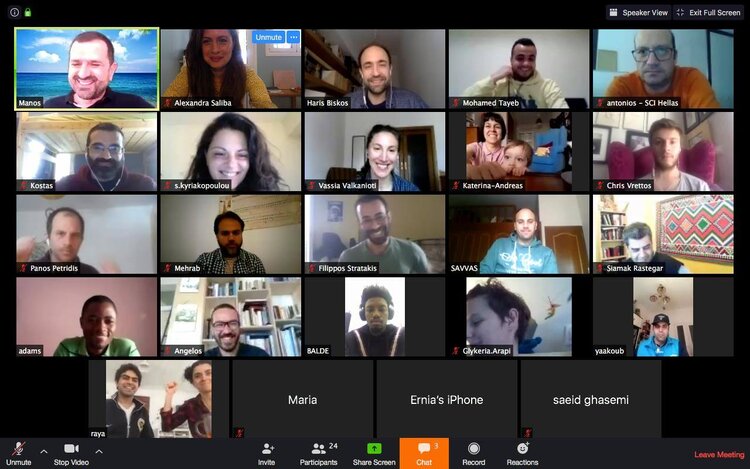
2.7 Communication
The project’s visibility was significantly increasing during the course of 2020. Two scientific papers focusing on Curing the Limbo were presented at an online conference organised in Cambridge. The papers were discussing some of the early conclusions of language classes and the audio-visual courses of the Education programme, very well received by the academic community. During the Covid-19 lockdowns, communication officers put more emphasis on social media visibility with regular post and updates regarding different aspects of the programme. A new, monthly internal newsletter was created and distributed among team members, with a section dedicated to each pillar of the project. In physical space, the exhibition created to showcase the photographs of refugees taken during the first lockdown was a great way to reach out to wider audiences.
The reassignment of most activities and communication to the online domain was sometimes an advantage when it came to the visibility and public communication of the project. On the other hand, internal communication between consortium members and the organisers of various pillars, as well as outreach to beneficiaries was harmed more by the nearly-exclusively online communication channels.
As noted earlier on in the reflection, the restrictions connected to the Covid-19 pandemic paradoxically brought the organisers of Curing the Limbo more time to reflect on the project retrospectively, and to plan the remainder of the programme and conceive its legacy. Team meetings, both within given pillars and between different teams at large, became more frequent which led to more internal communication than before and allowed to re-think some internal procedures in the partnership. The Curing the Limbo teams also had more time to articulate the experiences gained during the project, compiling lessons learnt about the most testing aspects and challenges of the programme, to be used for the “Athens’ lessons shared” guidebook.
“What is now a big challenge is how we can look back at what we have achieved and come up with a more cohesive narrative of our trajectory. Retrospectively, it looks like a very cohesive project and articulating the lessons learnt will strengthen this narrative.” Thalia Dragona
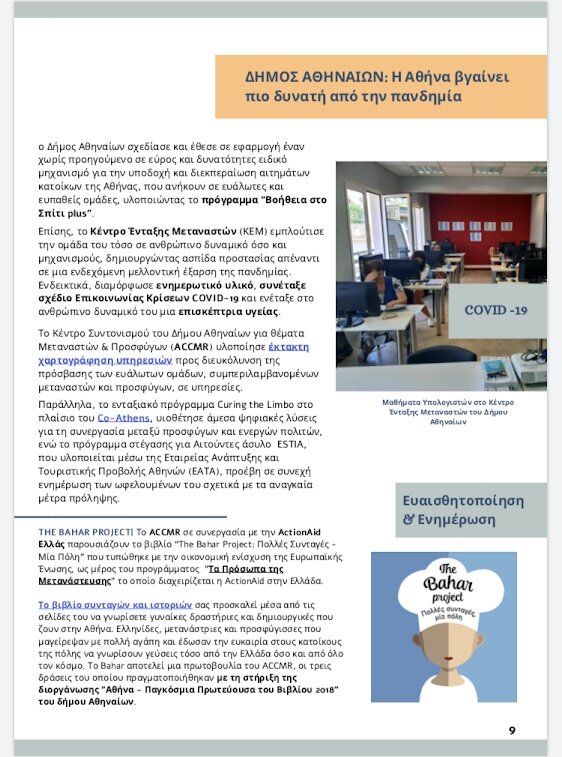
3 Challenges
|
TABLE 1: MAPPING CURING THE LIMBO AGAINST THE ESTABLISHED UIA CHALLENGES |
||
|
Challenge |
Level of risk |
Observations |
|
1.Leadership for implementation |
Low |
After initial fears of the incoming municipal administration and its relationship to refugee integration as a whole and the Curing the Limbo project in particular, cooperation with the municipality has been evolving positively. The appointed counsellor to the Mayor, responsible for refugee and migrant issues, became very involved in Curing the Limbo, bringing about a better prospective of working with the municipality. This involvement helped the project regain a favourable place within the municipal administration. |
|
2.Public procurement |
Low |
In the last period of the project, with all staff hired for all positions, there were no more procurement challenges for the project. However, with a significant delay with hiring ICT teachers, for instance, it was difficult to synchronise student expectations and teacher availabilities and some ICT courses began with very few students. With little time left of the project, this issue could not be solved, therefore the impact of procurement difficulties is long-lasting. |
|
3.Integrated cross-departmental working |
Medium |
The Covid-19 pandemic and the subsequent lockdowns gave another layer to internal communication between partners and the municipality. Forced to adapt to the lockdown situation, Curing the Limbo teams were quick to move their meetings online and this gave the consortium additional space top exchange ideas and suggestions. The digitalisation of communication has paradoxically helped cooperation between partners as they had more time available for coordinating actions. The relationship with the municipality has moved forward with a counsellor to the Mayor who got very involved in the project, thus helping the embeddedness of the project in the public administration. While the counsellor’s involvement helped the project’s situation and acceptance, Curing the Limbo still remained rather foreign to municipal services, due to its initiation by a previous vice-mayor and the repositioning of the theme within municipal priorities. |
|
4. Adopting a participative approach |
Low |
The participation of beneficiaries and partners in co-designing various processes remained at the core of the Curing the Limbo project even in the period marked by Covid-19. However, with the elimination of possibilities to meet in person, participatory mechanisms also had to be moved online. This transition was not equally easy for all beneficiaries or partners, not everyone having the same access to internet and digital tools. However, new digital communication channels between teachers and students, for example, opened new possibilities for participation. In some cases, digitalisation even created access to the project’s services for people who earlier could not access them, thus broadening the outreach of Curing the Limbo. |
|
5. Monitoring and evaluation |
Medium |
Despite the disruptions of Covid-19, the Curing the Limbo consortium has been engaged with evaluating the results of the project. Besides following the evaluation and monitoring plans elaborated earlier, team members have also worked on disseminating the project’s findings to a broader audience, building a more coherent narrative of the project and formulating a series of policy recommendations based on the project’s experiences. However, not having agreed to evaluation indicators before project start has been a very big challenge to the project, as collecting the relevant data retrospectively to correspond with indicators defined later was a time-consuming effort. |
|
6. Financial Sustainability |
Medium |
Reaching the last phase of the project, there has been an increasing attention on the sustainability of the project. It was established that some of the education, employment and community involvement elements of Curing the Limbo could be implemented addressing other marginal and disadvantaged groups, depending on available funding from different sources, ranging from EU subsidies for refugees, climate adaptation or else, as well as from local or national budgets. Furthermore, with its work on developing a social rental agency, CRS has been consciously designing a sustainable financial model for the continuation of Curing the limbo’s housing programme that would still depend on public support from the Athens municipality or the Greek state. |
|
7. Communicating with target beneficiaries |
Low |
The Covid-19 pandemic and the subsequent lockdowns have seriously challenged communication with beneficiaries. With no more physical gatherings possible, the programme lost its direct physical relationship both with the beneficiaries of its services and trainings, and with the participants of its citizen initiatives. Similarly, the Serafio complex ceased to be the centre of all activities, thus interrupting the personal connections formed between beneficiaries and members of the Curing the limbo team. However, with the transition to new communication channels, some of these links have been re-established and other ones were created, reaching beneficiaries who were previously not capable of attending trainings and events in person. Therefore, the pandemic had an ambiguous impact on communication with beneficiaries, re-structuring relationships. |
|
8. Upscaling |
Low |
In the final phases of developing the education and integration mechanisms of Curing the Limbo, consortium members have focussed on transferring, multiplying and upscaling some of the tools and instruments they elaborated. As explored in various scientific papers, the curricula developed for the educational and employment pillars of the project can be used in relation with other marginalised groups (low-income majority groups, people with long unemployment history, etc.) as well as in other contexts where a strong civil society and active entrepreneurial tissue makes it possible to create strong links between education, employment, community activism and entrepreneurship. The collaborative approach of synAthina can be transferred to other policy areas like climate emergency, where civic initiatives can be encouraged to come up with solutions to emerging challenges. The social rental agency conceived by CRS and external experts, but not yet implemented, can establish a long-term housing model for the larger Athens region, inspired by Curing the Limbo’s accommodation pillar. |
4 Take away points
a) Mapping: explore how other institutions and initiatives react to a crisis or a disruptive event and try learning from them.
b) Adaptation: rethink services in the light of changing conditions, turning challenges into advantages.
c) Outreach: develop alternative ways to reach out to your community, in case previous communication channels are disrupted.
d) Recycling: use your existing tools for new purposes, adapting to changing circumstances.
e) Collaboration: build on the collective intelligence of your partnership or community to come up with new ways of working together during a crisis.
f) Inclusion: think about the weakest link of an activity or the weakest member of a communication chain, and strengthen these elements of the system.
g) Learning: let students teach the teachers when new circumstances necessitate new tools and approaches.
h) Transfer: think about the transferability of the mechanisms invented in the project to other fields.
i) Narrative: build a narrative of the project retrospectively to see what is missing from a cohesive project.
j) Legacy: Start thinking about the project’s legacy early on, returning to this issue regularly.
5 Conclusions
Curing the Limbo, like many other projects and initiatives, has been profoundly disrupted by the Covid-19 pandemic. From the consortium members’ viewpoint, the year 2020 was marked by a radical transformation of the project’s context in various waves, and by a series of attempts and measures to adjust the consortium’s work to the changing circumstances.
The consortium’s response was quick: while moving all internal communications online, the Curing the Limbo team reached out to all beneficiaries, trying to keep them on board of the programme. The digitalisation of all communication activities was feasible because of the consortium’s capacity to quickly adapt to changing circumstances, helped by the project’s flexible action-research methodology. Moving activities online brought partners closer together: the shared challenge to overcome the isolating effects of the pandemic and the additional time to discuss strengthened the partnership’s cohesion and the partners’ knowledge about each other. With serious efforts to maintain communication, cooperation and the project’s services, both Curing the Limbo staff and beneficiaries demonstrated a strong commitment to the programme.
The difficulties brought to Curing the Limbo by the pandemic and the lockdowns, were softened by a series of external factors. On the one hand, the solidarity initiatives emerging with the health crisis gave a cohesive sentiment to the Athenian society, tempering the animosity directed towards migrants and refugees before the pandemic. On the other hand, cooperation with the municipality has been improved due to the municipal advisors’ increasing interest in the programme, opening new potentials for the programme’s reliance on the municipal departments and their long-term plans.
In the last period of Curing the Limbo, consortium members have renewed their involvement in defining a strong long-term legacy for the programme. The various partners have re-explored the possible transferring, multiplying and upscaling some of the tools and instruments they elaborated. As explored in various scientific papers, the curricula developed for the educational and employment pillars of the project can be used in relation with other marginalised groups (low-income majority groups, people with long unemployment history, etc.) as well as in other contexts where a strong civil society and active entrepreneurial tissue makes it possible to create strong links between education, employment, community activism and entrepreneurship. The collaborative approach of synAthina can be transferred to other fields like climate emergency, where civic initiatives can be encouraged to come up with solutions to emerging challenges. The social rental agency conceived by CRS and external experts, but not yet implemented, can establish a long-term housing model inspired by Curing the Limbo’s accommodation pillar.
Reaching the last phase of the project, there has been an increasing attention on the sustainability of the project. It was established that some of the education, employment and community involvement elements of Curing the Limbo could be implemented addressing other marginal and disadvantaged groups, depending on available funding from different sources, ranging from EU subsidies for refugees, climate adaptation or else, as well as from local or national budgets.. Furthermore, with its work on developing a social rental agency, CRS has been consciously designing a sustainable financial model for the continuation of Curing the limbo’s housing programme. however, its establishment and maintenance needs stronger political commitment and support.
About this resource
The Urban Innovative Actions (UIA) is a European Union initiative that provided funding to urban areas across Europe to test new and unproven solutions to urban challenges. The initiative had a total ERDF budget of €372 million for 2014-2020.
Similar content




